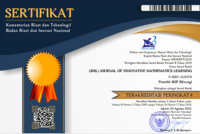Analysis Of Junior High School Students' Mathematical Creative Thinking Ability Reviewed By Gender
DOI:
https://doi.org/10.22460/jiml.v7i1.18560Keywords:
Mathematical Creative Thinking Ability, Gender, Junior High SchoolAbstract
References
Abidin, J., Rohaeti, E. E., & Afrilianto, M. (2018). Analisis Kemampuan Berfikir Kreatif Matematis Siswa Smp Kelas Viii Pada Materi Bangun Ruang. JPMI (Jurnal Pembelajaran Matematika Inovatif), 1(4), 779. https://doi.org/10.22460/jpmi.v1i4.p779-784
Arifin, M., & Bharata, H. (2017). Proses Berpikir Kreatif Matematis Siswa Ditinjau Dari Pengetahuan Awal Tinggi Dan Perspektif Gender. Posiding Seminar Nasional Matematika Dan Pendidikan Matematika 2017, 1, 175–184.
Astra, R. R. S., Vilela, A., Pereira, J., & Zou, S. (2022). Pengaruh Gender Terhadap Kemampuan Berpikir Kreatif Siswa Smp Yang Telah Memperoleh Pendekatan Rme. … Matematika Inovatif), 5(1), 307–316. https://doi.org/10.22460/jpmi.v5i1.307-316
Dilla, S. C., Hidayat, W., & Rohaeti, E. E. (2018). Faktor gender dan resiliensi dalam pencapaian kemampuan berpikir kreatif matematis siswa SMA. Journal of Medives: Journal of Mathematics Education IKIP Veteran Semarang, 2(1), 129–136.
Fardah, D. K. (2012). Analisis Proses dan Kemampuan Berpikir Kreatif Siswa Dalam Matematika Melalui Tugas Open-Ended. Semarang: Universitas Negeri Semarang. Jurnal Kreano, 3(2), 1–10. https://journal.unnes.ac.id/nju/index.php/kreano/article/view/2616
Gais, Z., & Afriansyah, E. A. (2017). Analisis Kemampuan Siswa Dalam Menyelesaikan Soal High. Mosharafa, 6, 255–266.
Hendriana, H., Rohaeti, E. E., & Sumarmo, U. (2017). Hard skills dan soft skills matematik siswa. Bandung: Refika Aditama.
Ismaimuza, D. (2013). Pengaruh Pembelajaran Berbasis Masalah Dengan Strategi Konflik Kognitif Terhadap Kemampuan Berpikir Kritis Matematis Dan Sikap Siswa Smp. Jurnal Pendidikan Matematika, 4(1). https://doi.org/10.22342/jpm.4.1.305.
MZ, Z. A. (2013). Perspektif Gender Dalam Pembelajaran Matematika. Marwah: Jurnal Perempuan, Agama Dan Jender, 12(1), 15. https://doi.org/10.24014/marwah.v12i1.511
Nugraha, T. H., & Pujiastuti, H. (2019). Analisis Kemampuan Komunikasi Matematis Siswa Berdasarkan Perbedaan Gender. Edumatica : Jurnal Pendidikan Matematika, 9(1), 1–7. https://doi.org/10.22437/edumatica.v9i1.5880
Potur, A. A., & Barkul, Ö. (2009). Gender and creative thinking in education: A theoretical and experimental overview. A| Z ITU Journal of the Faculty of Architecture, 6(02), 44–57.
Purwanti, R. D., Pratiwi, D. D., & Rinaldi, A. (2016). Pengaruh Pembelajaran Berbatuan Geogebra terhadap Pemahaman Konsep Matematis ditinjau dari Gaya Kognitif. Al-Jabar : Jurnal Pendidikan Matematika, 7(1), 115–122. https://doi.org/10.24042/ajpm.v7i1.131
Putra, H. D., Akhdiyat, A. M., Setiany, E. P., & Andiarani, M. (2018). Kemampuan berpikir kreatif matematik siswa SMP di Cimahi. Kreano, Jurnal Matematika Kreatif-Inovatif, 9(1), 47–53.
Rahayu, D. V., & Afriansyah, E. A. (2015). Matematik Siswa Melalui Model Pembelajaran Pelangi Matematika. Mosharafa: Jurnal Pendidikan Matematika, 5(1), 29–37. http://www.e-mosharafa.org/index.php/mosharafa/article/view/mv4n1_4/201
Rusman. (2011). Model-model pembelajaran: Mengembangkan profesionalisme guru. Rajawali Pers/PT Raja Grafindo Persada.
Ülger, K. (2016). Öğrencilerin Yaratici Düşünme Ve Eleştirel Düşünme Becerileri Arasindaki Ilişki. Hacettepe Egitim Dergisi, 31(4), 695–710. https://doi.org/10.16986/HUJE.2016018493
Downloads
Published
Issue
Section
License
Copyright (c) 2023 (JIML) JOURNAL OF INNOVATIVE MATHEMATICS LEARNING

This work is licensed under a Creative Commons Attribution-ShareAlike 4.0 International License.
The author is responsible for acquiring the permission(s) to reproduce any copyrighted figures, tables, data, or text that are being used in the submitted paper. Authors should note that text quotations of more than 250 words from a published or copyrighted work will require grant of permission from the original publisher to reprint. The written permission letter(s) must be submitted together with the manuscript.
























